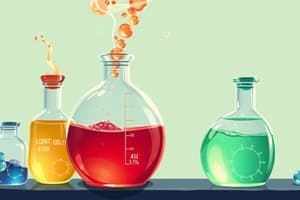Podcast
Questions and Answers
Why is mixing reactants in non-stoichiometric amounts problematic in a chemical reaction?
Why is mixing reactants in non-stoichiometric amounts problematic in a chemical reaction?
- It decreases the temperature required for the reaction
- One reactant will be used up before the others, limiting the product yield (correct)
- It speeds up the reaction rate
- It increases the yield of the product
What are the two factors that affect the yield of a product in a chemical reaction?
What are the two factors that affect the yield of a product in a chemical reaction?
- Amount of the starting materials and temperature
- Mole ratio and pressure
- Amount of the starting materials and pressure
- Mole ratio and temperature (correct)
What determines which reactant is the limiting reactant in a chemical reaction?
What determines which reactant is the limiting reactant in a chemical reaction?
- The mole ratio of the reactants (correct)
- The atomic weight of the reactants
- The cost of the reactants
- The color of the reactants
How does limiting reactant affect the yield of a chemical reaction?
How does limiting reactant affect the yield of a chemical reaction?
What is stoichiometry in a chemical reaction?
What is stoichiometry in a chemical reaction?
Which of the following statements accurately describes the role of the limiting reactant in a chemical reaction?
Which of the following statements accurately describes the role of the limiting reactant in a chemical reaction?
If a reaction has the balanced equation 2A + 3B → C, and the initial amounts of A and B are not in the stoichiometric ratio, which of the following statements is true?
If a reaction has the balanced equation 2A + 3B → C, and the initial amounts of A and B are not in the stoichiometric ratio, which of the following statements is true?
In a reaction involving the decomposition of $\mathrm{NaHCO_3}$ (sodium bicarbonate) to form $\mathrm{Na_2CO_3}$ (sodium carbonate), $\mathrm{CO_2}$ (carbon dioxide), and $\mathrm{H_2O}$ (water), which of the following statements is true if $\mathrm{NaHCO_3}$ is the limiting reactant?
In a reaction involving the decomposition of $\mathrm{NaHCO_3}$ (sodium bicarbonate) to form $\mathrm{Na_2CO_3}$ (sodium carbonate), $\mathrm{CO_2}$ (carbon dioxide), and $\mathrm{H_2O}$ (water), which of the following statements is true if $\mathrm{NaHCO_3}$ is the limiting reactant?
Suppose a reaction has the balanced equation 2X + Y → 3Z, and the initial amounts of X and Y are 10 moles and 8 moles, respectively. What is the limiting reactant in this case?
Suppose a reaction has the balanced equation 2X + Y → 3Z, and the initial amounts of X and Y are 10 moles and 8 moles, respectively. What is the limiting reactant in this case?
In a reaction involving the combustion of methane ($\mathrm{CH_4}$) and oxygen ($\mathrm{O_2}$) to produce carbon dioxide ($\mathrm{CO_2}$) and water ($\mathrm{H_2O}$), which of the following statements is true if $\mathrm{O_2}$ is the limiting reactant?
In a reaction involving the combustion of methane ($\mathrm{CH_4}$) and oxygen ($\mathrm{O_2}$) to produce carbon dioxide ($\mathrm{CO_2}$) and water ($\mathrm{H_2O}$), which of the following statements is true if $\mathrm{O_2}$ is the limiting reactant?
Flashcards are hidden until you start studying
Study Notes
Chemical Reaction Factors
- Two factors affect the yield of product in a chemical reaction:
- The amount of starting materials (reactants) is one of the factors.
Stoichiometry
- Chemicals react according to fixed mole ratio (stoichiometry).
- Reactants are used up in the correct amounts according to the balanced equation.
- All reactants are used up during the reaction in stoichiometric amounts.
Limiting Reactant
- When reactants are not mixed in the correct mole ratio (non-stoichiometric amounts), one reactant will be used up before the others.
- The reactant that is used up first limits the amount of product formed.
Studying That Suits You
Use AI to generate personalized quizzes and flashcards to suit your learning preferences.




